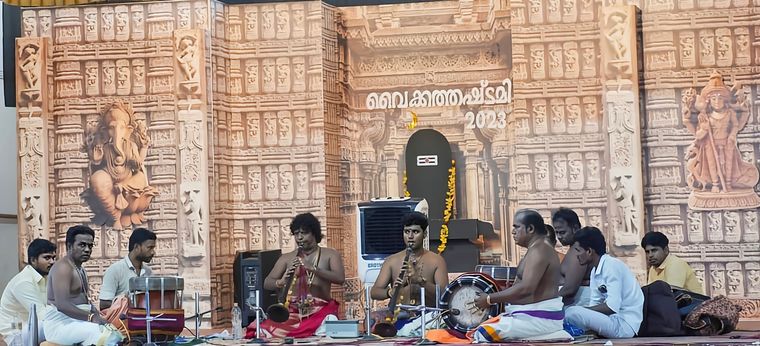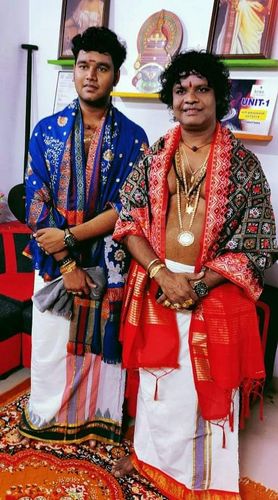By the rivers of Babylon, there we sat down and wept, when we remembered Zion. Upon the willows in the midst of it, we hung our harps.
The poignant verses from Psalm 137 in the Bible’s Old Testament echo the lament of men, women and children forced to leave their homes centuries ago. Like the lamentations in the psalm, nadaswaram maestro Yazhpanam P.S. Balamurugan was also forcefully displaced once.
As a teenager, he, too, had shed tears, wondering whether a curse hung over him and his people―the Sri Lankan Tamils. However, even while growing up during the civil war, Balamurugan never hung up his double reed wind instrument.
“When I was 15, our family had to flee our house in Nallur,”recalls Balamurugan. “For nearly six months, we lived in a place that was 30km away from our village. We lived in temporary sheds; we did not have any money, and had almost nothing to eat.” Even in that situation, his father, Suppuswami Pillai, insisted that he practise the nadaswaram. “He believed that if I managed to stay alive, this music would be the key to sustaining myself and making a living,” he says. “I obeyed him.”
Born in 1980, Balamurugan belongs to a generation that bore the brunt of the devastating civil war in the island nation. Witnessing death and bloodshed was almost a daily affair. For the first 22 years of his life, he hardly travelled outside Jaffna. Today, he is a globetrotter and one of the most sought-after musicians worldwide. He has a soft corner for south India for its knowledge and appreciation of Carnatic music.
“Nadaswaram is not at all an easy instrument to master,” says S.P. Sreekumar, principal of Kshetra Kalapeedam, Vaikom. “In the contemporary musical world, there is hardly any other nadaswaram artist who has earned such a legendary status at such a comparatively young age (43)…. A lot of nadaswaram players play the instrument, focusing only on swaras (notations). But Balamurugan is one of those artists who learn and play nadaswaram without mutilating the beauty of sahitya (lyrics) of a keerthana. That is one reason why we can just keep listening to his music for hours.”
And that was evident when he performed during the annual 13-day Ashtami festivities at the renowned Vaikom Mahadeva Temple in Kerala in early December. On the 11th day of the festival, Balamurugan’s music created the divine ambience for the hours-long Sribali and Vilakku rituals. On the 12th day, he conducted a four-hour-long concert. His son, P.S. Sarang, 21, joined him with the nadaswaram, whereas Kovilur K.G. Kalyanasundaram, Mettupalayam M.S. Ravikumar and Eguvarpalayam E.M. Ganapathy set the rhythm with their thavil. Balamurugan enthralled the audience with raga vistharam (slow and rhythmically free improvisation that sets the mood for the subsequent composition) in Kokilapriya ragam. He then proceeded to play mano dharma―an on-the-spot improvisation while adhering to the musical grammar―in Shuddha Saveri, a raga that is also used in music therapy for alleviating depression and instilling a positive outlook. That same night, Balamurugan enthralled a larger audience with his hours-long performance for the Ashtami Vilakku ritual.
Like his music, there is something calming about Balamurugan, thanks to his humility and ready smile. When THE WEEK visited him in Vaikom, he was taking a nap to get over the jet lag from his long flight (Germany-Colombo-Thiruvananthapuram). But when Kavalam Sreekumar, a thavil expert from Kerala who collaborates with him, told him that we were there to interview him, he promptly joined us. He sat for the interview without a shirt on, just like he does in his performances. “I started playing the nadaswaram at the age of five,” he says. “My appa, who was an aasthana vidhwan (a recognised musician) of the Nallur Kandaswamy Kovil for 40 years, was my first guru.”

Music runs in his family. Balamurugan’s grandfather, Ponnuswami, had moved to Jaffna from Pudukottai in Tamil Nadu in the first half of the last century, looking for opportunities to play the nadaswaram. Meanwhile, Balamurugan’s maternal grandfather was a mrudangam expert. Apart from the nadaswaram, Suppuswami could play the thavil, nattuvangam, ghatam and ganjira. As a child, Balamurugan was more inclined to play the thavil, a barrel-shaped percussion instrument, but his father insisted he concentrate on the nadaswaram. Occasionally, he would play the thavil at a temple without his father’s knowledge, and would end up getting an earful when he came to know about it.
Balamurugan studied only till class four, but his musical training continued for long because of his father. At eight, he was first sent to study the nadaswaram in the gurukulam tradition, which required him to reside at the guru’s house. Over the next four years, he studied under esteemed teachers like Shivaswami Pillai, Maapettapuram Shanmukhanadan Pillai and Thururaaja Pillai. When he was not training, he would repeatedly listen to tapes featuring maestros such as Maharajapuram Santhanam and Madurai Somu. During the late 1980s and early 1990s, when power supply was erratic in his village and battery sales were restricted over concerns of misuse in bomb-making, Balamurugan ingeniously overcame the challenge. He connected his audio cassette player to the dynamo wires of his bicycle, pedalling nonstop to keep the music on.
For a brief period, Balamurugan stayed at home. But when he was 13, Suppuswami again sent him for training, this time to the house of renowned maestro Alaveddy N.K. Padmanathan in Yazhpanam. “My guru came to Yazhpanam after the Indian Peace Keeping Force killed his son in Alaveddy,”recalls Balamurugan. He barely learned four varnams and seven or eight kritis there, but the life lessons he acquired and the techniques he mastered, including the art of blowing the nadaswaram from his lower belly, have stayed with him. “I used to serve at his home, closely observing his daily routine and noting the specific activities he engaged in throughout the day. His day typically began at 4am, and even when he was over 60, he maintained a disciplined practice routine. The sound of his practice served as my morning alarm,” he recalls. “There were no structured classes. When he felt like giving a lesson, he would call, ‘thambi inke vaa (come here, child).’He didn’t repeat instructions, and I had to be always prepared for an impromptu lesson.”
At 15, Balamurugan was home again. However, as the civil war escalated, his family, like many others, had to flee the village. “People abandoned the village, carrying whatever belongings they had in a desperate attempt to stay alive,” he says. “We all moved together like a procession along the Jaffna Road. There were deliberate attacks against those of us who were fleeing.” He remembers a girl walking ahead with her family. “Holding a tiffin box in her hand, she cried due to hunger, and her parents reassured her that they would eat soon,” he says. “Tragically, just a few minutes later, she died in an explosion right before our eyes. The most horrifying part was that we were unable to help them or anyone else, as we were also running for our lives.”
While living as refugees, Balamurugan’s family, comprising his parents and four siblings, slept in a trench within their makeshift shelter. “Every other family did the same to mitigate the impact in case of a bomb blast,” he says. “I distinctly remember how, during bombings and firings, my parents would gather us children in the middle and embrace us, hoping to shield us. Despite selling all our belongings, my father remained steadfast in his commitment to ensuring my musical education.” A nadaswaram master named Inavil Balakrishnan was also seeking shelter in a temporary shed. And, Suppuswami requested him to teach Balamurugan some keerthanams.
Nearly six months after leaving the village, the Sri Lankan army recaptured the region, and all those who were living in shelters started their journey back home. “We once again covered the entire distance of more than 30km to return to Nallur,” he recounts. “My father resumed working at the Murugan temple, occasionally sending me to play there. Soon, invitations from other temples started pouring in, and from 1997 onwards, I began participating in major festivals at nearby temples.”
Even at the age of 17, his father continued to make decisions for him. “There was a renowned musical duo named Ganamurthy-Panchamurthy. When Panchamurthy relocated to Colombo, Ganamurthy needed a nadaswaram artist for a concert and reached out to me,”recalls Balamurugan. “During that period, I was unable to make decisions independently. So I directed him to seek approval from my father. Consequently, I joined Ganamurthy and played alongside him for nearly five years. This opportunity allowed me to meet and interact with various masters and experts, listening to their conversations and musical performances.”
In 2003, he received his first international invitation from Singapore to perform at a temple. “Until then, my knowledge of the world was confined to a mere 30km radius,” he says, chuckling. Within a couple of years, Tamil expatriates began reaching out to him from various countries, including the UK, US and Australia.
Following the conversation with THE WEEK, Balamurugan got ready for a performance at the Vaikom temple. When he emerged, he was adorned with jewellery and resembled a deity. And that imagery showed he could embody the utmost divinity through his music, while embracing profound humanity in his everyday life.
―with B. Manojkumar



